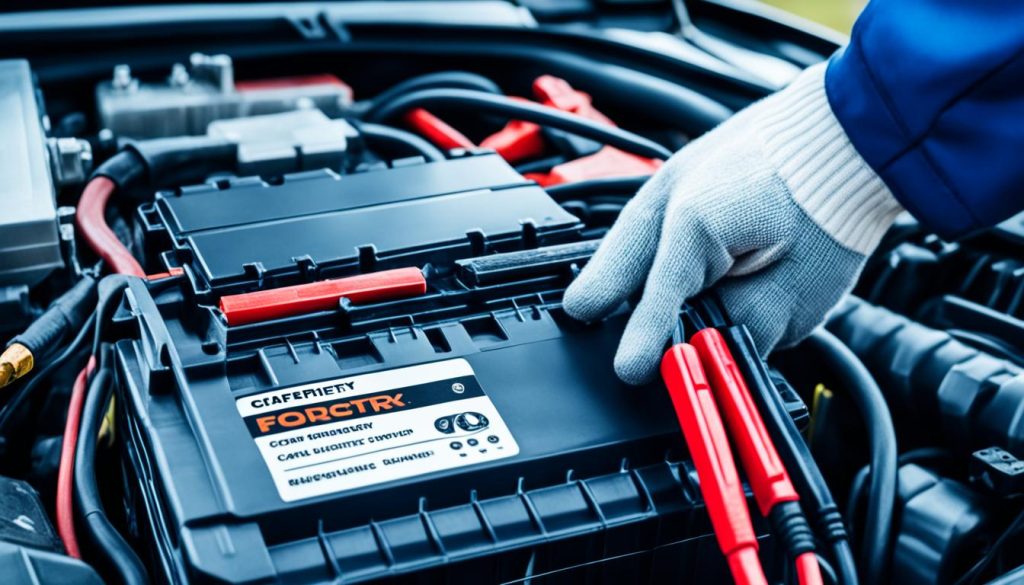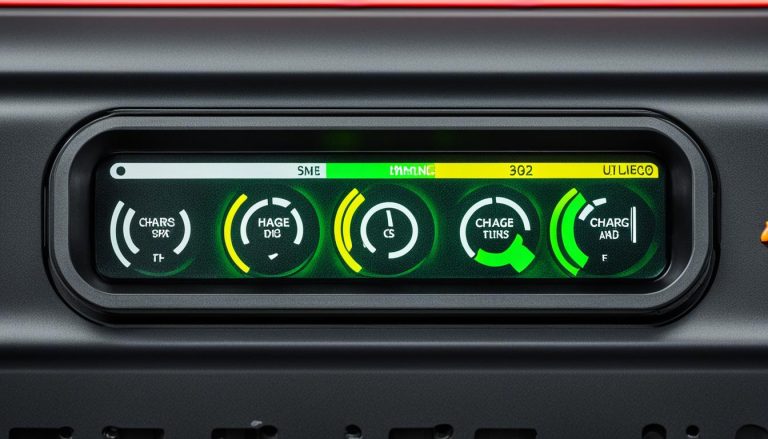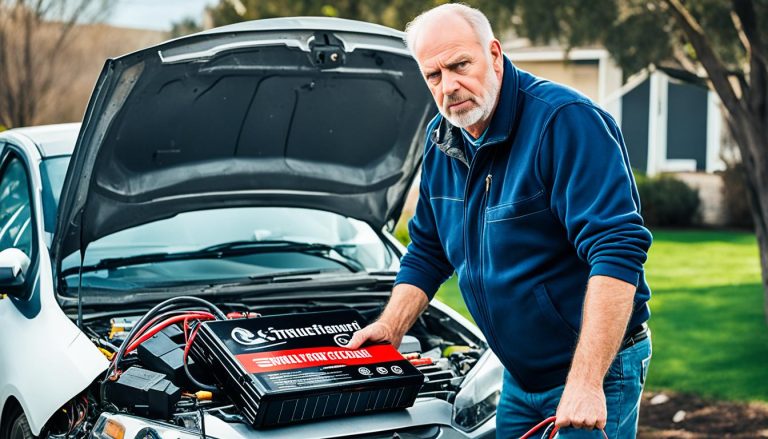Jump Starting a Car: Does It Damage the Battery?
batterychargers.site and its partners may earn a commission if you purchase a product through one of our links
Have you ever found yourself in a situation where your car won’t start, and the only solution appears to be a car battery jump start? You’re not alone! This scenario is particularly common during the colder months. It’s natural to worry about jump start car battery damage, but with proper guidance, you can perform this task safely. Ensuring jump start battery safety involves a few straightforward precautions. It’s like following a recipe – measure correctly, move step by step, and voila, you’ll have your engine purring in no time.
Understandably, you might hesitate. After all, your vehicle isn’t just transportation; it’s a vital part of your daily routine. The good news is that when you follow the right steps, the risk of damaging your battery with a jump start is minimal. So let’s alleviate those concerns and help you get back on the road with confidence.
Key Takeaways
- Jump starting a battery is mostly safe, given that you strictly adhere to the safety guidelines.
- It’s vital to ensure both vehicles involved are turned off before connecting any cables.
- Properly connecting cables in the correct order is crucial to prevent damage to your car’s electrical systems.
- For those who feel uncertain about the process, using a jump starter pack can provide a safer alternative.
- Know the difference between a drained battery, which typically needs a jump to recharge, versus a dead battery that may require a full replacement.
- Consult your vehicle’s owner’s manual for specific instructions to prevent any potential risk associated with a jump start.
Understanding Car Battery Issues in Cold Weather
As the temperature drops, your car’s battery faces unique challenges that can increase the risks of jump-starting a car. Understanding what happens to your battery in cold weather can help you prevent unexpected troubles and understand the effects of jump-starting a car battery.
Why Batteries are Susceptible to Cold
Cold temperatures can be a battery’s nemesis. This is due to the fact that the chemical reactions required to generate power in a car battery slow down in colder temperatures, thus diminishing the battery’s ability to hold and deliver charge. Moreover, winter conditions often require more power to heat up your car and run defrosters, placing additional strain on the battery.
The Impact of Seasonal Temperature Changes on Battery Health
Seasonal changes can wreak havoc on your car’s battery. Summer heat accelerates corrosion within the battery, degrading its internal structure. This damage often comes to light during the winter when the weakened battery may fail to perform in the lower temperatures. Consequently, these seasonal extremes can play a significant role in the increased frequency of jump starts during the colder months.
Preventive Measures to Shield Your Battery from Cold Damage
Fortunately, there are preventive measures you can take to protect your battery from the cold. Here are some steps you can follow:
- Regularly test your battery’s voltage to ensure it’s operating at peak capacity.
- Keep your car in a garage overnight to shield it from the harshest temperatures.
- Service your vehicle regularly, especially the electrical system, to prevent undue stress on your battery.
- Consider replacing your battery before winter if it’s near the end of its typical life span of 3-4 years.
By being proactive about your car’s battery health, you can significantly reduce the need for jump starts and mitigate the risks associated with them during the frigid winter months.
The Safety of Jump Starting Your Vehicle
When your vehicle refuses to start, and you’re facing a dead battery, jump starting can be a lifesaver. However, to ensure your safety and the health of your vehicle’s electrical system, there are essential precautions for jump starting a car that you must follow. Not only do these steps help in preventing damage, but they also contribute to a successful jump without unnecessary risks.
To start, it’s crucial that before you even pick up jumper cables, both vehicles are turned off. This seems obvious, but in the moment, it’s an easy detail to overlook. Any accidental contact between the vehicles should be avoided as well—this isn’t just about preventing scratches but ensuring there’s no pathway for an electrical shortcut which could be damaging.
Connecting to the dead battery first is more than just a best practice; it’s a measure that lays the foundation for a safe jump start. It’s essential to handle live cables with the utmost care to prevent sparks or shorts. A solid knowledge of your vehicle’s owner’s manual instructions is non-negotiable—they’re there for your safety and may contain vehicle-specific steps vital for a safe jump start.
- Ensure all electronics are off in both vehicles.
- Wear protective gear such as safety glasses and gloves.
- Check both batteries for damages or leaks before proceeding.
- Never smoke or allow open flames near a battery.
For those who may feel uneasy using jumper cables, investing in a reliable jump starter pack can offer a safe and efficient solution. These packs are typically easy to use and eliminate the need for a second vehicle, which is particularly handy when you’re alone or in a remote location.
| Precaution | Rationale | Action |
|---|---|---|
| Both vehicles turned off | Prevents electrical surges and potential sparks | Turn off ignition in both cars before attaching cables |
| No contact between vehicles | Avoids creating an electric circuit | Park the cars close but not touching, ideally a car’s length apart |
| Proper cable connection | Ensures efficient and safe power transfer | Connect positive to dead battery first, then to good |
| Follow owner’s manual | Manufacturer-specific guidelines | Check the manual for any unique instructions for your vehicle |
Remember, taking the time to acquaint yourself with these jump start dead battery precautions will not only ensure a smooth experience but can also extend the life of your car battery and electrical system. Jump starting a car may seem intimidating, but by using the right techniques and knowing the proper steps, you can do it safely and confidently.

Does jump starting a car damage the battery
It’s a question that may keep you up at night if you’ve just helped your neighbor with a set of jumper cables: could that good deed have caused damage to either of your car batteries? Rest assured, when the procedure is done right, jump starting a car without damaging the battery is entirely possible. In this section, we’ll dissect common misconceptions and provide clarity on maintaining your battery’s health post-jump start.
What Constitutes a Drained vs. Dead Battery?
The distinction between a drained battery (temporarily out of charge) and a dead battery (incapable of holding a charge) is critical. Drained batteries often occur from scenarios like leaving the headlights on and can often come back to life with a boost and some drive time to recharge. On the contrary, a dead battery is typically at the end of its lifecycle due to reasons like age or corrosion and will most likely need replacement.

Assessing Battery Health Post-Jump Start
After successfully jump starting your car, it’s wise to assess your battery’s health. If your vehicle starts up right away the next time, it’s a good sign that the battery was just drained. However, if you’re consistently needing a jump, your battery may be signaling its last days. The good news is that a healthy battery should be unaffected by a jump start. But there is a caveat: inconsistencies or errors in jump starting technique can risk jump start car battery damage. Always follow proper guidelines and consult your owner’s manual for best practices tailored to your vehicle.
Jump Start Misconceptions and Your Car’s Alternator
Many drivers worry about the implications of jump starts on their car’s alternator. While the alternator’s job is to charge the battery while the engine runs, it’s not designed to charge a dead battery. This means that too frequent jump starts, followed by short drives that don’t allow for adequate recharging, can lead to undue stress on the alternator. Ensure your drives post-jump start are long enough to replenish the battery’s charge without overworking the alternator. Understanding these nuances can keep your vehicle running smoothly and steer you clear of unnecessary repair costs.
Proper Techniques for Jump Starting Without Risk
When faced with a dead battery, the thought of jump starting a car without damaging the battery may seem daunting. However, with a few key precautions for jump starting a car, you can revive your vehicle’s power source safely. It’s essential to follow a systematic approach, which often includes a set of jumper cables as your primary tool. These are typically color-coded, red for positive (+) and black for negative (-), to mitigate the risk of an accidental short circuit.
Remember, safety is paramount; thus, it is crucial to avoid rushing through the process. Before proceeding, ensure that both vehicles—the one providing the charge and the one receiving it—are turned off. Then, open the hoods and locate each battery and its respective terminals. To guide you step-by-step, here’s a clear-cut table with the proper sequence to follow:
| Step | Action | Explanation |
|---|---|---|
| 1 | Connect positive clamp to dead battery | Identify the positive terminal, marked by the plus symbol or red color, and attach the red clamp. |
| 2 | Connect positive clamp to good battery | Similarly, attach the other red clamp to the good battery’s positive terminal. |
| 3 | Connect negative clamp to good battery | Now, clamp the black cable to the negative terminal of the good battery. |
| 4 | Ground on the car with dead battery | Finally, attach the last black clamp to an unpainted metal surface on your car’s engine block, away from the battery. |
| 5 | Start the donor car | Turn on the working vehicle and let it run for a few minutes to charge the dead battery. |
| 6 | Attempt to start your car | Try to start your vehicle. If it doesn’t turn on right away, give it a few more minutes, then try again. |
| 7 | Remove clamps in reverse order | Once started, carefully remove the clamps in the reverse order of how you connected them. |
If you lack confidence in jump starting your vehicle or fear the risk of damaging sensitive electrical components, seeking professional roadside assistance is your best bet. The peace of mind that comes with expert handling is often unmatched, as they are equipped with the right tools and know-how for the situation.
Always follow these guidelines but refer to your vehicle’s owner’s manual for specific instructions that might be unique to your car model. Practicing these precautions for jump starting a car will reduce the likelihood of causing damage and leave you prepared to handle situations involving power loss effectively.

In conclusion, understanding the correct sequence and process of connecting jumper cables is essential. By adhering to this protocol, you are not only ensuring your personal safety but also protecting your vehicle from potential electrical harm. Patience and precision are key components when dealing with a dead battery, and should you face any uncertainty, do not hesitate to call a professional.
Tackling the Risks: Jump Starting Modern Vehicles
With the advanced technology integrated into today’s cars, your vehicle’s electrical system is more complex than ever, boasting a network of ECUs (Electronic Control Units) that operate everything from your infotainment system to your car’s stability controls. Understanding the intricacies is crucial because the effects of jump starting a car battery incorrectly can be more than just inconvenient; they can be outright harmful. This article will guide you through the maze of modern automotive electronics to ensure you can mitigate the risks of jump starting a car.
The Complexity of Today’s Car Electrical Systems
The architecture of modern electrical systems in vehicles resembles a finely tuned symphony, where each component must perform in perfect harmony. However, this complexity introduces new vulnerabilities, particularly when jump starting is conducted without proper care. The central role of ECUs, often numbering in the dozens within even mainstream models, means that the stakes are higher should something go wrong during a jump start. By being aware of this complexity, you are better positioned to approach the task with the caution it demands.
Consequences of Incorrect Jump Starting on Electronics
When the process isn’t handle with due diligence, the risks of jump starting a car can manifest in several unwelcome ways. An improper connection or a surge of power can fry sensitive electronics, leading to errors and failures across various systems. These malfunctions not only impede your vehicle’s performance, but they may also saddle you with substantial repair bills. Certain effects of jump starting a car battery, such as compromised safety features, can have far-reaching implications for both your safety and your wallet.
Navigating the Electronic Landscape with Expertise
Your best defense against potential mishaps is to arm yourself with knowledge and the right equipment. High-quality jumper leads with built-in surge protection or reliable jump start packs are investments that safeguard your car’s electronic labyrinth. Moreover, the owner’s manual is your blueprint for your specific model’s needs, so follow it meticulously. In cases where the battery is visibly damaged or if it smells like rotten eggs, it’s a clear sign that professional assistance is the wisest path forward. If you find yourself unconfident about the process, or when your vehicle doesn’t restart after a jump, do not hesitate to call on road assistance experts who are trained to navigate the electronic intricacies of your car. This ensures that you’re not trading a temporary fix for long-term electronic woes.
FAQ
Can jump starting a car damage the battery?
Jump starting a car does not typically damage a healthy battery if done correctly. However, it’s important to follow the proper procedure to avoid any potential risks.
Why are batteries more susceptible to issues during cold weather?
Cold weather slows down the chemical reactions inside a battery, reducing its efficiency and power output, which often leads to a higher incidence of dead batteries needing a jump start.
How do seasonal temperature changes affect car battery health?
Extreme temperatures, both hot and cold, can significantly impact the lifespan and performance of your car battery. Cold weather demands more power from the battery, while heat can cause internal damage and shorten its life.
What are some preventive measures to protect my battery from cold damage?
To protect your battery from cold damage, keep it fully charged, park your car in a garage, and consider using a battery maintainer. Also, ensure your car’s scheduled maintenance, including timely oil changes and battery checks, is up to date.
How can I jump start my vehicle safely?
To jump start your vehicle safely, make sure both cars are turned off before connecting jumper cables, follow the correct cable connection sequence, and check your vehicle’s manual for specific instructions.
What is the difference between a drained battery and a dead battery?
A drained battery has been depleted of its charge typically due to factors such as leaving lights on, while a dead battery is one that is no longer able to hold a charge due to age, deterioration, or damage.
How can I assess my battery’s health after a jump start?
After jump starting, drive the car for at least 30 minutes to help recharge the battery. If the car starts consistently after this, the battery is likely fine; if not, it may need a professional evaluation or replacement.
Does jump starting a car put unnecessary stress on the alternator?
Jump starting a car when done correctly does not harm the alternator. Problems can occur if the process is done improperly or if the alternator was already weakened beforehand.
What techniques should I follow to jump start a car without risking damage?
To avoid risk when jump starting a car, use high-quality cables, follow the correct order in connecting and disconnecting the cables, and be sure to connect the positive clamp to the positive terminal and the negative clamp to a ground on the engine block of the car with the good battery.
How complex are modern car electrical systems when it comes to jump starting?
Modern vehicles have intricate electrical systems with multiple electronic control units (ECUs), which can make jump starting more complex and potentially risky if done incorrectly.
What could happen if I incorrectly jump start a car with advanced electronics?
Incorrect jump starting can lead to electrical surges that may damage sensitive electronic components such as ECUs, which control various functions within modern vehicles.
Should I seek professional help when dealing with a modern vehicle’s electronic system for a jump start?
Yes, if you’re unsure about the jump starting process or if your vehicle has a complex electronic system, it is safest to seek professional help from roadside assistance services to avoid the risk of costly damage.






